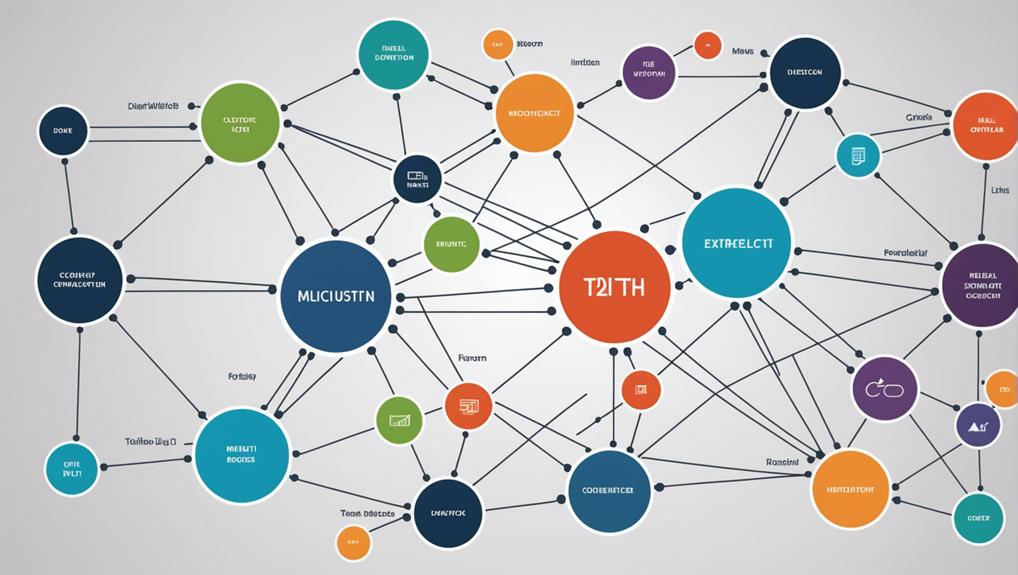To perform an SEO audit on your blog, start by conducting a website crawl to uncover technical issues and duplicate content. Fix any indexing problems and optimize for a better user experience. Enhance page speed by optimizing images and minimizing HTTP requests; use tools like GTMetrix. Review on-page SEO elements such as title tags, meta descriptions, and H1 tags. Evaluate your backlink profile for quality and relevance, disavowing any toxic links. Regularly monitor organic traffic trends with Google Analytics and identify content gaps. By following these steps, you'll greatly improve your blog's SEO performance. Discover the full details next.
Key Takeaways
- Run a website crawl with tools like Screaming Frog to identify and fix technical issues like broken links and missing meta tags.
- Use Google Search Console to resolve crawl errors and ensure all blog pages are accessible to search engines.
- Optimize page speed by minimizing HTTP requests and improving loading times to enhance user experience and SEO visibility.
- Conduct on-page SEO audits, optimizing title tags, meta descriptions, H1 tags, and internal linking for better search engine rankings.
- Analyze and improve mobile responsiveness using Google's Mobile-Friendly Test Tool to ensure a seamless user experience on various devices.
Run a Website Crawl
Running a website crawl with tools like Screaming Frog is essential for analyzing your blog's SEO health and identifying technical issues such as broken links and missing meta tags. A thorough crawl provides a detailed overview of your blog's structure, content, and technical elements, enabling you to pinpoint areas that need improvement. By addressing these issues, you'll enhance your blog's user experience and optimize it for search engines.
When you run a crawl, pay close attention to broken links. These links can negatively impact your blog's credibility and user experience. Fixing them guarantees that visitors can navigate your site without encountering dead ends. Additionally, check for missing meta tags, as these are vital for search engine indexing and improving your blog's visibility.
Another critical aspect revealed by a website crawl is the quality of your backlinks. Explore backlink strategies to identify and rectify any low-quality or spammy backlinks that could be harming your SEO. High-quality backlinks, on the other hand, will greatly boost your search engine rankings.
Ultimately, running a website crawl is a fundamental step in your SEO audit, helping you identify technical flaws and optimize your blog for better search engine performance and user engagement.
Check for Duplicate Content
To guarantee your blog's SEO performance, it is important to identify duplicate pages. Tools like Siteliner or Copyscape can help in this process. These tools assist in spotting content issues that can confuse search engines and potentially lower search rankings.
Consolidating similar content is crucial. By doing so, you can streamline your website and avoid diluting your SEO efforts. Additionally, using canonical tags to indicate preferred versions of content can significantly improve your SEO metrics. This practice helps search engines understand which version of the content should be prioritized, ultimately benefiting your website's search visibility.
Identify Duplicate Pages
Identifying duplicate pages on your blog is crucial for maintaining peak SEO performance and avoiding potential penalties from search engines. Duplicate pages can dilute your ranking power, making it essential to address this issue promptly.
Start by using tools like Screaming Frog or Sitebulb to crawl your website and identify instances of duplicate content. These tools can help you find URL variations, different tracking parameters, or cases of content syndication that may be causing duplication.
Once you've identified duplicate pages, you need to implement canonical tags to inform search engines which version of the page should be considered the primary one. This ensures that the ranking power is consolidated into a single URL, improving your SEO performance.
Additionally, you should redirect duplicate pages to their canonical versions using 301 redirects. This not only helps with SEO but also ensures a seamless user experience by preventing visitors from landing on multiple versions of the same content.
Use Plagiarism Checkers
Utilizing plagiarism checkers like Copyscape and Grammarly is an essential step to guarantee all your blog content remains original and not duplicated from other sources. Regularly running these tools is vital for effective content monitoring and implementing plagiarism prevention strategies. Duplicate content can greatly harm your SEO rankings and may lead to penalties from search engines, so maintaining originality is important.
Plagiarism Checker | Key Features
—————— | ————-
Copyscape | Detects duplicate content across the web
Grammarly | Provides detailed reports and suggestions
Small SEO Tools | Free and easy-to-use plagiarism detection
To minimize copyright infringement risks, you should consistently review your content using these checkers. When you find any duplicate content, address it promptly and ensure proper citation best practices are followed. This not only protects your blog from legal issues but also maintains its credibility and integrity.
Consolidate Similar Content
With duplicate content posing a significant threat to SEO, consolidating similar content is essential for maintaining your blog's ranking authority and search engine clarity. Duplicate content risks include confusing search engines and splitting your ranking authority, which can severely impact your blog's visibility.
To identify duplicate content, leverage tools like Screaming Frog. This crawler will help you pinpoint identical or substantially similar URLs. Once identified, apply effective content consolidation strategies. One approach is to redirect duplicate URLs to a single, preferred version using 301 redirects. This method consolidates ranking signals and guarantees search engines index the correct page.
Another technical solution is implementing canonical tags. Canonical tags signal to search engines which URL should be considered the primary version, thereby reducing the negative impact on ranking caused by duplicate content.
Regular audits are essential. Consistently check for duplicate content to maintain a clean, optimized blog structure. By adopting these SEO benefits, you not only mitigate duplicate content risks but also enhance your blog's overall search engine performance.
Combining these strategies ensures your blog remains authoritative and clearly understood by search engines, boosting its ranking potential.
Fix Indexing Issues
Start by leveraging Google Search Console to pinpoint and resolve pages on your blog that Google can't index. This tool is essential for indexing troubleshooting, offering insights into which pages aren't indexed and why. Begin by checking the Coverage report to identify errors and warnings.
Use Screaming Frog to conduct a thorough crawl of your site. This tool helps uncover common indexing mistakes, such as accidentally blocked pages or missing meta tags. Screaming Frog's audit capabilities will highlight areas that need immediate attention.
Follow these steps to fix indexing issues:
- Identify Blocked Pages: Use Screaming Frog to detect pages blocked by robots.txt or noindex tags. Verify and adjust settings to ensure intended pages are indexable.
- Resolve Crawl Errors: In Google Search Console, address crawl errors such as 404 Not Found and 500 Server Errors. Fixing these issues helps Google access your pages effectively.
- Check Intentional Blocking: Confirm that pages like paginated comments are intentionally set to noindex. This prevents unnecessary indexing and improves crawl efficiency.
- Ensure Accessibility: Make sure all pages meant to be indexed are accessible to Google. Check for proper site structure and internal linking to enhance search visibility.
Improve Page Speed
Improving page speed is essential for both user experience and SEO.
Start by optimizing image sizes, as large images can greatly slow down your site. Studies show that images contribute to 21% of a webpage's total weight.
Additionally, minimize HTTP requests since each request can add latency. Reducing them can lead to a faster, more efficient site.
Optimize Image Sizes
Optimizing image sizes is crucial for enhancing page speed, as large files can significantly slow down load times and negatively impact SEO. Reducing image sizes not only improves user experience but also boosts your search engine rankings. To achieve this, you need to employ effective image optimization techniques and leverage image compression tools.
Here are four steps to optimize image sizes:
- Use Image Compression Tools: Tools like TinyPNG and JPEG Optimizer reduce file sizes without compromising quality. These tools effectively compress images, making them quicker to load.
- Implement Lazy Loading: Lazy loading defers offscreen images, making sure that only the images visible in the user's viewport are loaded initially. This reduces initial page load time and enhances site performance.
- Adopt Responsive Images: Use responsive image techniques to serve appropriately sized images based on the user's device. This ensures that mobile users aren't downloading large desktop images, which speeds up load times.
- Choose the Right Format: Opt for modern formats like WebP which offer superior compression compared to traditional formats like JPEG and PNG, without sacrificing image quality.
Minimize HTTP Requests
After optimizing your image sizes, it's important to minimize HTTP requests to further enhance your blog's page speed. Reducing server requests directly impacts load times, making your blog faster and improving the user experience.
Each HTTP request, whether it's for an image, CSS file, or JavaScript file, adds to the overall load time. Hence, fewer requests mean quicker load times.
One effective strategy is to combine CSS and JavaScript files. Instead of having multiple files, consolidate them into single files. This approach reduces the number of server requests greatly.
Additionally, consider using CSS sprites to combine multiple images into a single file, further reducing HTTP requests.
Optimizing images also plays an essential role. Even after resizing, make sure images are in formats that load quickly, such as WebP.
Tools like GTMetrix and PageSpeed Insights can help identify elements that generate excessive HTTP requests. By addressing these, you can enhance the user experience and boost your SEO performance.
Analyze Mobile Usability
Leverage Google Search Console to check mobile usability and make sure your blog is fully optimized for mobile devices. With mobile traffic surpassing desktop usage, it's crucial to focus on mobile design to enhance user experience. Google Search Console provides a detailed Mobile Usability report that identifies issues affecting your site's performance on mobile devices. Addressing these issues can boost your conversion rates and improve overall engagement.
Here are four steps to guarantee your blog is mobile-friendly:
- Use Google's Mobile-Friendly Test Tool: This tool evaluates how well your blog performs on mobile devices. It highlights specific problems and offers actionable recommendations.
- Optimize Layout and Content: Ensure your blog's layout adapts to various screen sizes. Use responsive design principles and prioritize readable fonts and touch-friendly buttons to enhance user experience.
- Check Loading Speed: Mobile users expect fast load times. Compress images, leverage browser caching, and use accelerated mobile pages (AMP) to speed up your site.
- Test Interactivity: Make sure all interactive elements, like menus and forms, function smoothly on mobile devices. Poor interactivity can frustrate users and lead to higher bounce rates.
Review Core Web Vitals
Ensuring your blog is mobile-friendly is just one piece of the puzzle; now, let's focus on reviewing Core Web Vitals to further enhance your site's performance and SEO.
Core Web Vitals encompass three key metrics: Largest Contentful Paint (LCP), First Input Delay (FID), and Cumulative Layout Shift (CLS). Google uses these metrics as ranking factors, meaning optimizing them is essential for your blog's visibility.
Start by evaluating your LCP, which measures how quickly the main content loads. To improve LCP, you need to optimize images by compressing and resizing them. This reduces load times and directly impacts your site's speed. Tools like Google PageSpeed Insights can help you identify opportunities for image optimization.
Next, review FID, which gauges the time it takes for your page to become interactive. Reducing JavaScript execution time is key here. Consider deferring non-essential scripts to ensure faster initial interaction.
Inspect On-Page SEO
To maximize your blog's search engine visibility, scrutinize each page for proper title tags, meta descriptions, and H1 tags. Leveraging tools like Yoast can help you analyze and improve these on-page elements, making sure that your keyword research aligns with your overall content strategy.
By following on-page SEO best practices, you can enhance your blog's ranking potential and attract more organic traffic.
Here are key steps to inspect on-page SEO:
- Title Tags: Verify each title tag is unique, under 60 characters, and includes your primary keyword. This improves click-through rates and search engine ranking.
- Meta Descriptions: Craft compelling meta descriptions under 160 characters that incorporate target keywords. They should entice users to click on your link over competitors.
- H1 Tags: Utilize a single H1 tag per page that clearly states the page's primary topic. This helps search engines understand the content's focus.
- Internal Linking: Optimize internal linking within your blog posts to improve site navigation and distribute page authority. This not only enhances user experience but also boosts SEO performance.
Regularly conduct on-page SEO audits to maintain high visibility in search results. Implementing a robust on-page SEO strategy grounded in solid keyword research and content strategy is essential for sustained success.
Evaluate Backlink Profile
Analyzing your blog's backlink profile involves evaluating the quality and relevance of the links pointing to your site to make sure they contribute positively to your SEO. Start by using tools like Ahrefs or SEMrush for an in-depth backlink analysis. These tools help identify toxic backlinks that could impact your blog's SEO. Check the domain authority and relevance of each link to assess link quality. High-quality backlinks from authoritative and relevant sites boost your SEO, while toxic backlinks might need to be disavowed.
Monitoring backlink growth over time is essential to track the impact of your link-building efforts. Regularly auditing and disavowing harmful backlinks ensures a healthy backlink profile.
Here's a quick comparison to guide you:
| Metric | High-Quality Backlinks | Toxic Backlinks |
|---|---|---|
| Domain Authority | High | Low or spammy |
| Relevance | Highly relevant to your niche | Irrelevant or unrelated |
| Impact on SEO | Positive | Negative |
| Identification Tools | Ahrefs, SEMrush | Ahrefs, SEMrush |
| Action | Build and maintain | Audit and disavow |
Perform Competitor Analysis
Gaining insights into your competitors' SEO strategies can greatly enhance your blog's performance. Start by identifying their top-performing content, keywords, and backlink strategies. Here's a detailed approach:
- Analyze Competitor Backlinks: Use tools like Ahrefs or SEMrush to examine the backlink profiles of your competitors. Identify the types of sites linking to them, the quality of these backlinks, and the anchor text used. This will help you understand which backlinks are driving high rankings and inform your own link-building strategy.
- Compare Social Engagement: Evaluate your competitors' social media presence and engagement levels using tools like BuzzSumo. Track metrics such as shares, likes, and comments to gauge which content resonates most with their audience. This can provide insights into content types and topics that you might want to explore.
- Benchmark Domain Authority and Organic Traffic: Utilize tools like Moz to compare your competitors' domain authority and organic traffic. This benchmarking allows you to see how your blog measures up and where you need to improve.
- Identify Content Gaps: Look for gaps in your competitors' content strategy and keyword targeting. Use this information to create content that fills these gaps, addressing unmet needs, and capturing audience attention.
Monitor Organic Traffic
Regularly monitor your organic traffic trends in Google Analytics to precisely assess your blog's performance over time. Begin by setting a date range of 6-8 months to capture meaningful data.
Analyzing traffic sources is essential; it helps you understand where your traffic is coming from and which channels are most effective. Look specifically at the organic search traffic to gauge the impact of your SEO efforts.
Benchmark your current organic traffic levels before making any changes. Flat or declining traffic is common and signals the need for an SEO audit. Post-audit, you should expect to see an upward trend in your organic traffic, indicating successful optimization.
Next, study user behavior to gain insights into how visitors interact with your blog. Pay attention to metrics such as bounce rate, average session duration, and pages per session. These indicators can reveal areas that need improvement, whether it's content quality or site usability.
Frequently Asked Questions
How Do You Do a SEO Content Audit?
Start your SEO content audit by conducting a keyword analysis and competitor benchmarking. Use tools like Google Analytics and SEMrush to evaluate traffic, engagement, conversions, and internal linking. Optimize your content based on these insights.
How to Conduct a Blog Audit?
To conduct a blog audit, identify technical errors, analyze backlinks, and evaluate content quality. Use tools like Yoast for SEO insights. Collect data, create an action plan, and adjust your strategy based on findings. Seek expert help if needed.
How Do I Do an SEO Audit on My Page?
You'll start by examining Technical SEO elements and site speed. Conduct a Backlink Analysis to assess domain authority. Use tools like Yoast SEO for on-page factors, then optimize keywords and internal links to boost search rankings.
How to Write a SEO Audit Report?
To write an SEO audit report, start with an Executive Summary. Include a Technical Analysis of performance metrics and detailed findings. Highlight technical SEO issues, analyze on-page factors, and conclude with actionable steps and a timeline.
Conclusion
Wrapping up your SEO audit, you've:
- Crawled your site
- Checked for duplicate content
- Fixed indexing issues
- Improved page speed
- Guaranteed mobile usability.
You've also:
- Inspected on-page SEO
- Evaluated your backlink profile
- Performed a competitor analysis.
Finally, monitor your organic traffic to track progress.
By systematically addressing these areas, you'll gain actionable insights to enhance your blog's performance, ultimately driving more traffic and achieving higher rankings.
Stay data-driven and keep refining your strategy for sustained success.




